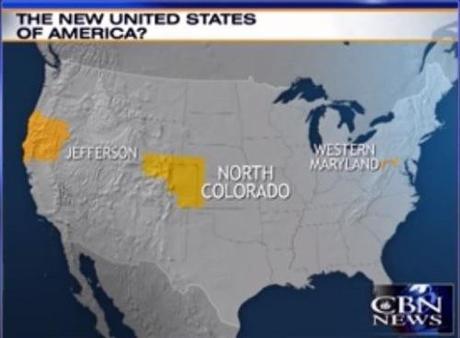Do you remember during the 2008 presidential campaign season, the POS saying at a campaign stop in Beaverton, Oregon, that he had visited 57 states with one more left to go?
Which meant Obama, Harvard constitutional law graduate and reputed smartest man in the world, thought there were 58 states in the United States of America.
Well, he may get his wish.
In addition to sky-high deficits, an official national debt of more than $17 trillion, unprecedented numbers of Americans on food stamps and Social Security Disability, racial relations in disrepair at home, utter disasters in foreign policy, and a ruined economy, President Lucifer’s legacy may well include a fragmented disUnited States of America, comprised of 53 or more states.

David Brody reports for CBN News, March 5, 2014, that a new secession movement is gaining steam because of frustration over a growing, out-of-control federal government.
A number of conservative, rural Americans are taking about seceding and creating their own states, meaning a new map of the United States of America could include the following:
- A 51st state called Jefferson, made up of Northern California and Southern Oregon
- A 52nd state called Western Maryland
- A 53rd state called North Colorado
Colorado
These are real movements gaining traction with voters across the country. Jeffrey Hare runs the 51st State Initiative in Colorado, an effort to fight an out-of-control legislature trying to ram big government policies down the throats of voters: ”We’re at this point of irreconcilable differences.”
Secessionist talk has filled town hall meetings and the divide discussed is not just ideological. ”It’s predominately left versus right, but it’s urban versus rural because you typically find more typical conservative values in rural America,” Hare said.
Rural Americans across many states feel they’re not being heard. Their laundry list is long and at the top of that list are stricter gun control laws.
According to Weld County, Colo., Sheriff John Cooke, the state legislature is out of control: ”They are out of touch with rural Colorado. There is an attack on rural Colorado and it’s not just on gun control laws. It’s on several of the other bills that they passed.” Government mandates on renewable energy, environmental policies restricting oil and gas drilling, and controversial social issues like gay marriage have also led to this divide and talk of secession.
Not everyone in Colorado thinks secession is a great idea. Colorado resident Greg Howe said, ”I don’t think that’s necessarily the way to make something happen within the area you live. You’re supposed to work within our electoral services.”
Organizers want to create “North Colorado,” an idea that went to voters in 11 counties this past fall, with mixed results. Some counties approved it. Others didn’t. But the organizers of the 51st State Initiative are undaunted, saying this type of movement takes time. Hare said, “Movements take a while; education takes time. People do have a hard time saying ,’I want to live in a different state,’ even though physically they live in the same house. It’s hard for them since their lives have been Coloradoans.”
Maryland
That desire for something different can also be felt in Arizona, Michigan, and in Western Maryland where thousands have signed secession petitions. One website reads, “We intend to exercise our right of self-determination and self-governance to better secure our rights to life, liberty, and the pursuit of happiness.”
Scott Strzelczyk, the leader of the Western Maryland movement, is ready to get going: “If they are not going to listen or take our needs into consideration and govern in a way that’s more in accordance with the way we want to be governed we are seeking an amicable divorce.”
California & Oregon
Meanwhile, in Northern California and Southern Oregon, activists want to come together in the state of “Jefferson.” Their proposed state flag includes two “Xs,” representing their feeling of being double-crossed by the state capitals of Sacramento, Calif., and Salem, Ore.
HOW TO CREATE A NEW STATE
Creating a new state isn’t easy. The last time a state actually gave up territory was in 1820, when Maine split from Massachusetts. Since then, additional efforts have been unsuccessful.
The first step is getting it passed by the state legislature and then the U.S. Congress. Hare said, ”This is a valid constitutional process that our founding fathers specifically wrote into the Constitution. Well, if they didn’t write this into the Constitution to be used, then why did they write it in?”
But supporters have an uphill battle since the media will not be their friend.
“The danger is once the outside media start to grab hold of it, the attention is on the difficulty, the almost impossibility of it happening,” professor Derek Everett, with Metropolitan State University in Denver, explained.
State secession proponents, like Roni Bell Sylvester of Colorado, say they will keep fighting because the dismissive attitude of state legislative bodies must end: “I find the sort of arrogant, dismissive to be further proof as to just how disconnected the urban is from the rural.”
Movements like the one in Colorado and other states could be just the beginning. It’s called “voter disconnect” where the people say they’ve had enough and are crying out for something to be done.
“We, at some point, have to figure out a way to get our point across or at least be able to have a dialog and not be ignored because you haven’t seen anything yet over the next 5 to 10 years,” one resident warned at a recent town hall meeting in Colorado.
As for Hare, he said it boils down to one simple concept: ”I think ultimately what people want, whether you look at it from a right or left paradigm, is government to stay out of their business.”
~Eowyn


posted on 09 March at 19:11
Not going to happen. Not enough room for more stars on your awkward flag.